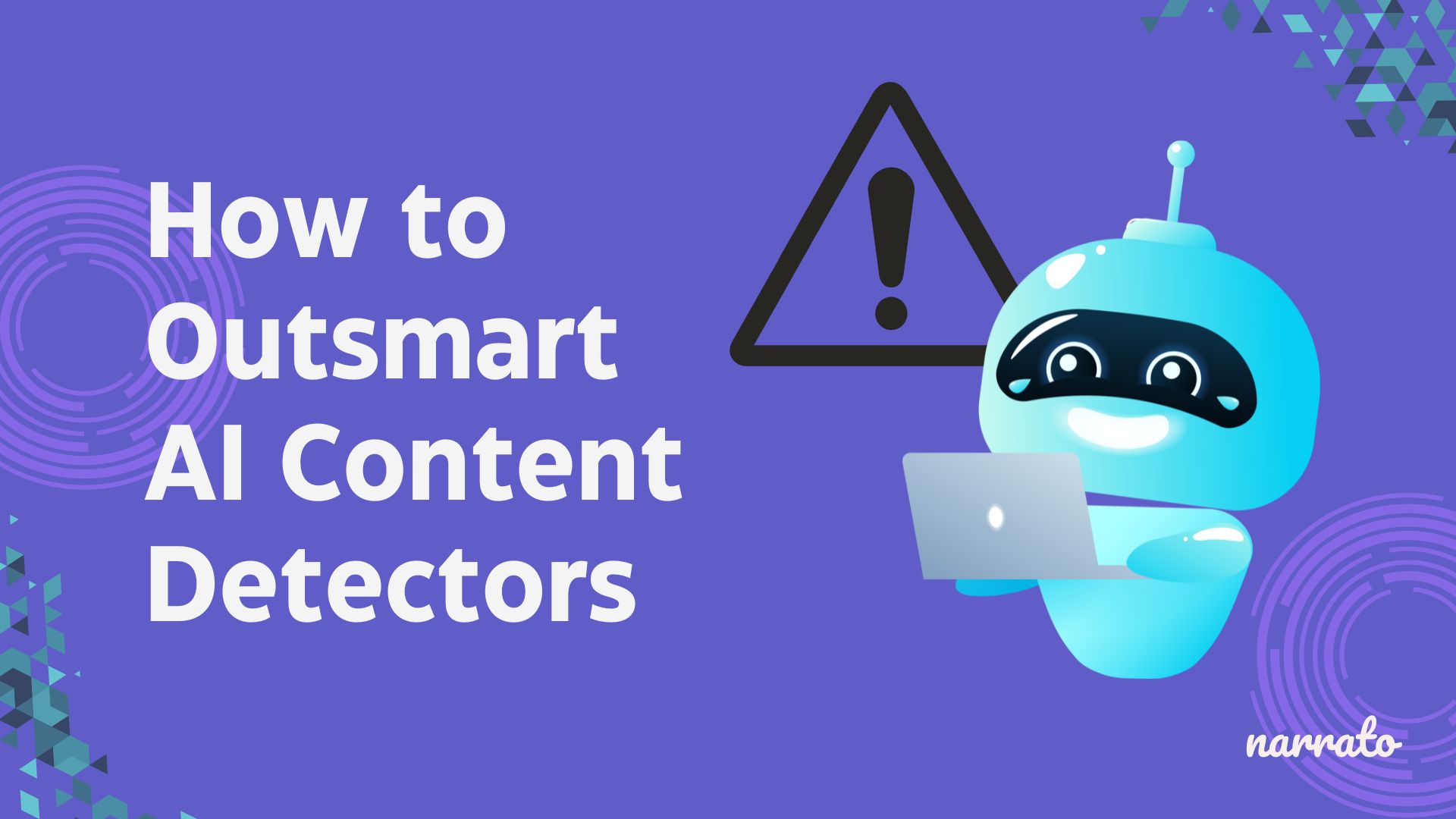AI content creation is undoubtedly a blessing for content marketers for the sheer amount of time it saves us. By minimizing the effort required to create a piece of quality content, AI writers and AI content idea generation tools are helping content teams devote more time to strategy building and delivering value to the audience. But AI content detectors can come in the way of your ‘happily ever after’ story with AI writing tools. Search engines as well as publishers want to ensure that they don’t serve up entire articles that are nothing but language model-generated text. This is where AI content detection steps in to try and help. But what exactly do AI content detectors do? Are they accurate? How can you bypass AI detection tools?
We will be answering all these questions and more in this article.
- What are AI Content Detectors?
- How does an AI content detector work?
- What happens if your content is flagged by AI Content Detectors?
- Is AI content bad for SEO? Can Google detect AI content?
- How to avoid AI content detection with these AI content creation best practices
- What to be careful about when trying to trick AI content detectors

What are AI Content Detectors?
AI content detectors, sometimes called GPT detectors, are algorithms designed to detect AI-generated content. Publishers or other stakeholders may use it to determine if a piece of content was written by artificial intelligence or has mostly human-written text. Though it is very difficult to actually differentiate between AI-generated text and that written by humans today, creators of generative AI detection tools are trying to make the technology more robust.
TL;DR Here’s a quick video summarizing this article.
How does an AI content detector work?
AI content detection tools are trained on the data, in quite the same way as AI content creation tools are trained. These tools use machine learning and natural language processing to understand and detect patterns in AI-generated text. The AI content detection tools are trained on large datasets of human-written text and AI-generated content. The algorithm works on the assumption that most AI-generated text will have certain characteristics like repetitiveness, lack of semantic meaning, lack of complexity, etc.
However, AI content detectors are not 100% trustworthy. There have been several instances of false negatives and false positives when these tools were put to test, according to a number of reports available online. In an experiment run by SurferSEO with the popular AI content detection tool, Originality.ai, the inaccuracy went on increasing when the targeted minimum ‘human written’ score was increased.
For the experiment, they took samples of 100 AI-generated and 100 human-written blog posts. When they targeted a minimum human written score of 80 on Orginality.io, the tool flagged over 20% of their human-written content as AI-generated. When the minimum score was set to 90, the inaccuracy was even higher, with 28% of the human-written articles detected as AI-generated.
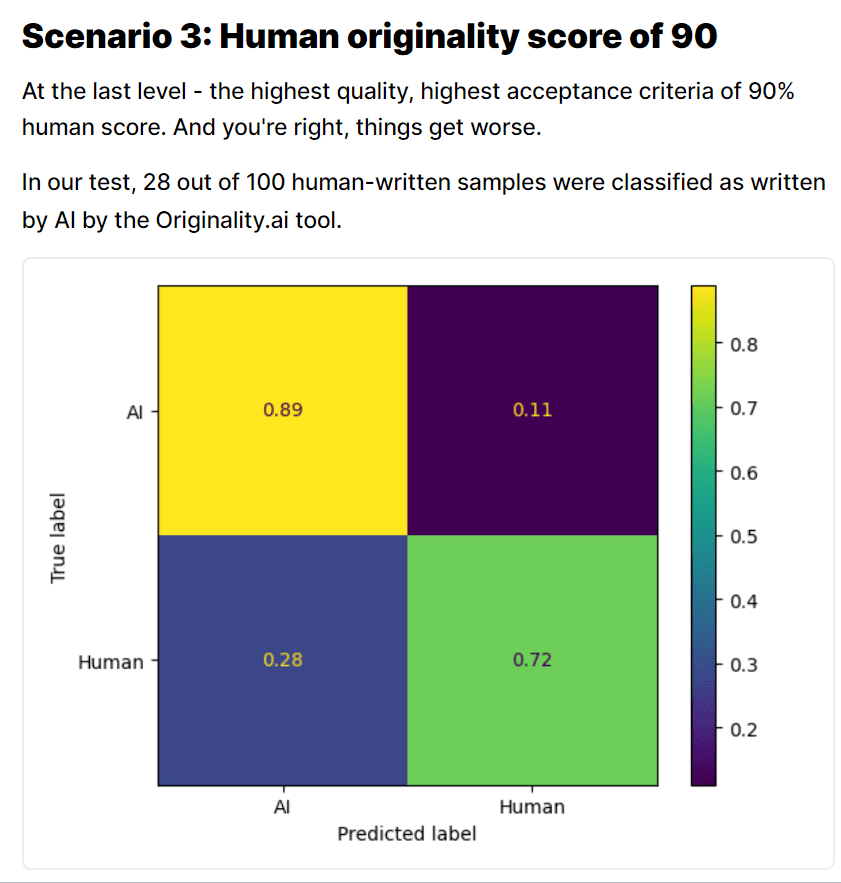
This means the more strictly the tool was meant to filter out AI content, the more inaccurate its results were.
But despite the technology still being in its nascent stages and not being too useful, it is best to take all precautions to avoid AI content detection as far as possible.
Additional Resource:
Narrato founder, Sophia Solanki, spoke to the team at Safety Detectives and answered some burning questions about AI content generation and data security. Click on the button below to read the complete interview.
What happens if your content is flagged by AI Content Detectors?
Getting flagged by an AI content detector does not have any direct impact on your content’s performance. You cannot deem AI-generated content as shallow or wrong as long as it is delivering value to the audience.
But at the same time, if your AI-generated content is factually incorrect or has no value to it, it can drop in search rankings and your traffic might take a hit. But this is true, irrespective of whether or not your content is flagged by an AI content detector.
Is AI content bad for SEO? Can Google detect AI content?
Another question that’s sure to cross your mind when we talk of SEO is this – Can Google detect AI content? Google has stated in Google Search’s guidance about AI-generated content that it does not care if the content is produced using AI or written by humans, as long as it is original, high-quality, and adheres to Google’s helpful content system.
In short, Google may detect AI content but it does not affect your search rankings as long as you’re writing for people and not search engines.
They have made it clear that if AI or automation in content production is used with the intent of manipulating search rankings, Google can detect it as spam and penalize the content.
But not all use of AI for content generation is spam. So if your content follows Google’s E-E-A-T requirements – expertise, experience, authoritativeness, and trustworthiness – it can rank well even if it was generated by artificial intelligence.
Here’s what Google states – “AI has the ability to power new levels of expression and creativity, and to serve as a critical tool to help people create great content for the web. This is in line with how we’ve always thought about empowering people with new technologies. We’ll continue taking this responsible approach, while also maintaining a high bar for information quality and the overall helpfulness of content on Search.”
To ensure that your content is not judged as spam by Google or flagged as AI content by publishers, here are a few things you should take care of.
How to avoid AI content detection with these AI content creation best practices
To ensure that your AI-generated content is not easily detectable to AI content detection tools, following these best practices when using AI writers to create content is essential. This can also help enhance your content quality and the reader’s experience. Because if the algorithm can detect AI-generated text, a smart reader may be able to tell the difference as well. Here are some tips to outsmart an AI content detector.
1. Do not create entire articles with AI content generators
This is the first and most important point we always like to stress. One of the biggest AI content creation mistakes you could make is to generate entire articles with an AI content writing tool. Generating content from start to finish with AI could result in inconsistencies, repetitions, and incoherent paragraphs, that are very easy for the GPT detectors to identify. Not just that, this lack of quality and flow can also be pointed out by your readers which could be very bad for your brand reputation.
It is important to remember that AI writing assistants are exactly that – assistants to make your job easier. They are not meant to replace your writers and their writing skills. AI content creation tools should only be used for generating small sections of a long article, or to overcome writer’s block and give you a headstart when you are stuck.
On Narrato’s AI writer too, you will notice that most of the use cases encourage you to create sectional content for your articles only. Use cases on the AI blog writer such as blog post outline, intro, conclusion, etc. are completely okay to use, as this means you are only using AI content in bits and pieces within your content. This makes it difficult for GPT detectors to flag your content as AI-written.
2. Take care of content structure
Another telltale sign of unsupervised, unmoderated use of AI in content creation could be a poor structure. If you are generating entire articles with AI writing tools without any human oversight, you would probably have a wall of text to publish. It is important that you pay attention to the structure of your articles and blog posts. A good quality piece of content would have shorter paragraphs, sufficient white spaces between paragraphs, images, etc. that make the piece less monotonous.
Even if you have generated a long section using AI content creation tools, a good way of tricking AI content detectors would be by breaking that section into smaller paragraphs. To make this faster and easier, run your content through a content optimization tool like Narrato’s AI content assistant. It will highlight excessively long sentences and paragraphs for you to edit, along with providing content improvement suggestions like grammar, spelling, etc.
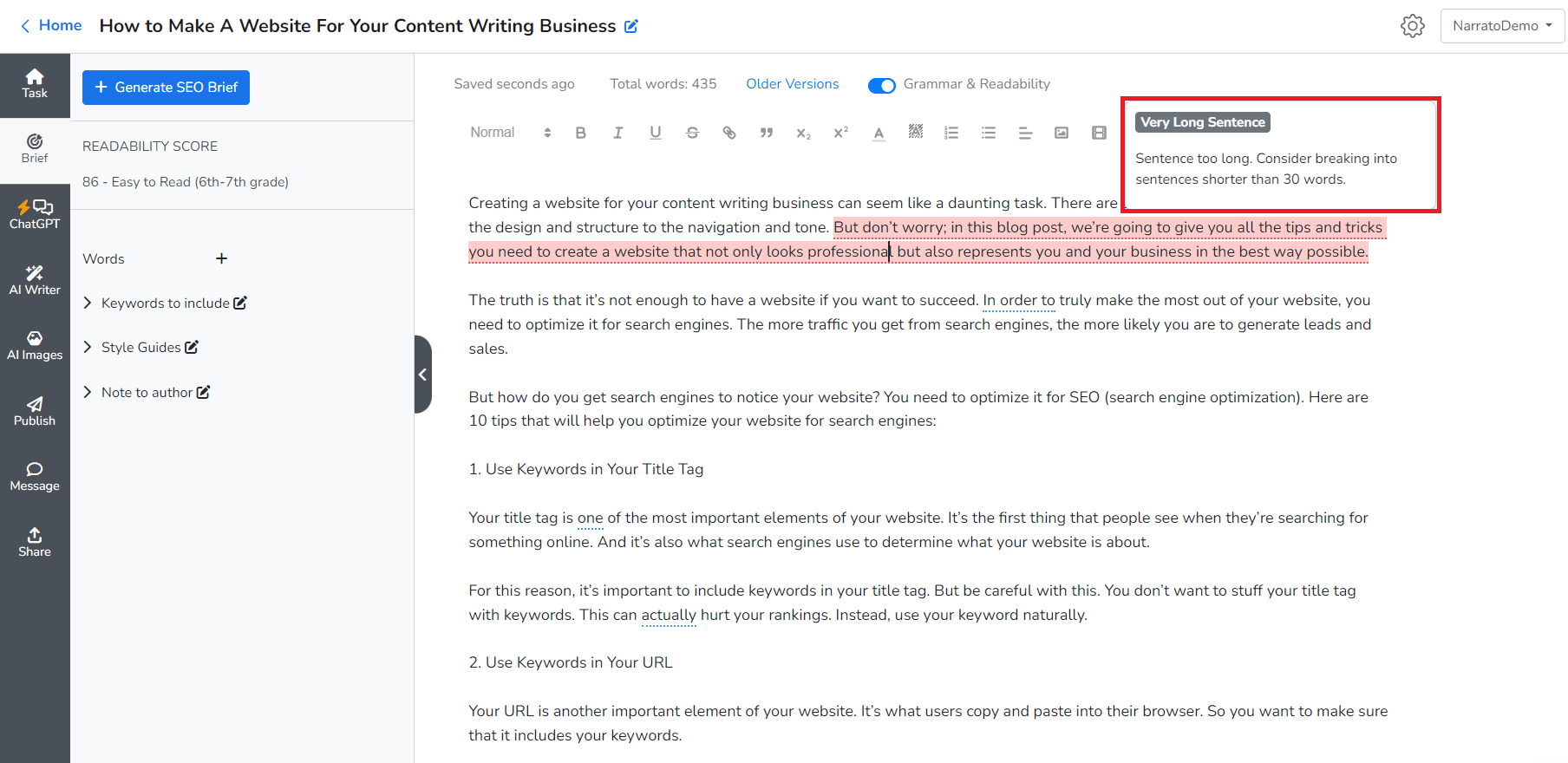
To further break down long text, you can insert images wherever relevant. AI image generation tools can be quite useful here, as they allow you to create custom images that would complement your content. You may also use emojis if your content’s purpose and audience allow it. This will add some diversity and will make pattern detection harder for the GPT detectors.

3. Diversify the vocabulary
Generating long-form content with AI writing tools can often result in excessive use of certain words or repetition of some ideas. Because AI content generation tools are trained on existing data, they are likely to pick words and ideas that occur most frequently in the training datasets.
Patterns like these could be easy to detect for AI content detection tools. Bypassing AI content detection would require you to expand the vocabulary in your content. Try and identify repetitive words and use synonyms instead. Look for words that sound too formal or impersonal and replace them with more conversational language. You can also use contractions like “don’t”, “can’t”, “should’ve”, etc. as most times an AI tool wouldn’t use these.
You should also look for repetition of ideas and replace them with something more substantial. Using Narrato AI writing assistant’s ‘Content Improver’ use case could make this easier for you. In the example below, we used the content improver to rewrite the paragraph highlighted in yellow. The output of the AI tool was the paragraph highlighted in orange, and it definitely sounded more casual and conversational.
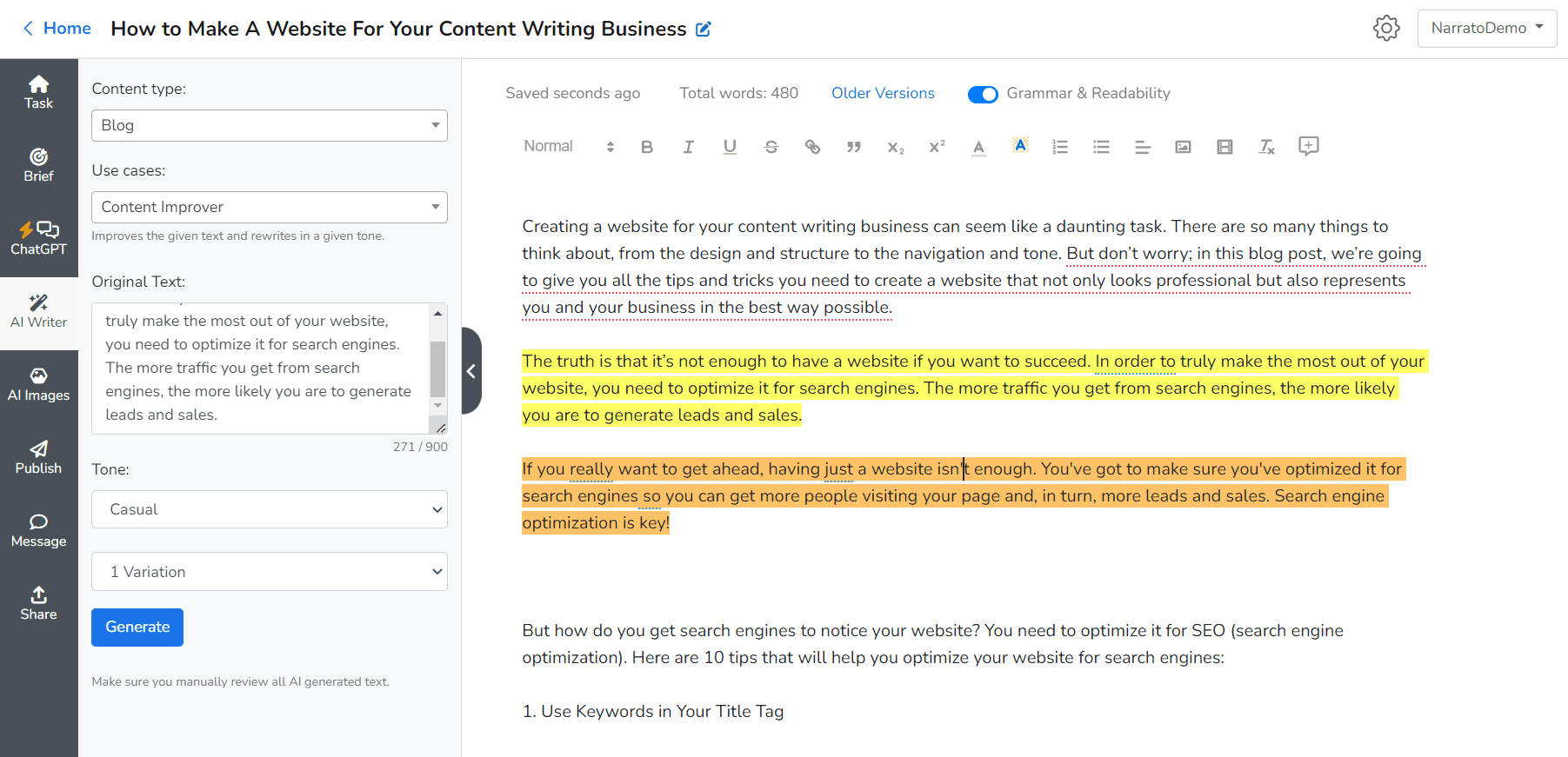
4. Paraphrase the AI-generated content
The best way of bypassing AI content detectors is probably rephrasing the AI-generated text to make it sound different while keeping the idea intact. But doing this manually every time you generate AI content will defeat the purpose of using an AI tool for content creation and you’d rather save some time if you wrote it from scratch.
You can, however, use a paraphrasing tool to do this quickly. Yes, we’re talking about using an AI tool to rewrite content that’s already generated by AI for tricking an AI content detector. Paraphrasing tools will rewrite your AI-generated content in a fresh and new style, without changing its meaning. You could use tools like ChatGPT for this. Or you could use the paraphrasing use case on Narrato’s AI writer.
In the example below, we’ve paraphrased the introductory paragraph of the blog article using the AI writer, and the highlighted text is what we got out of it.
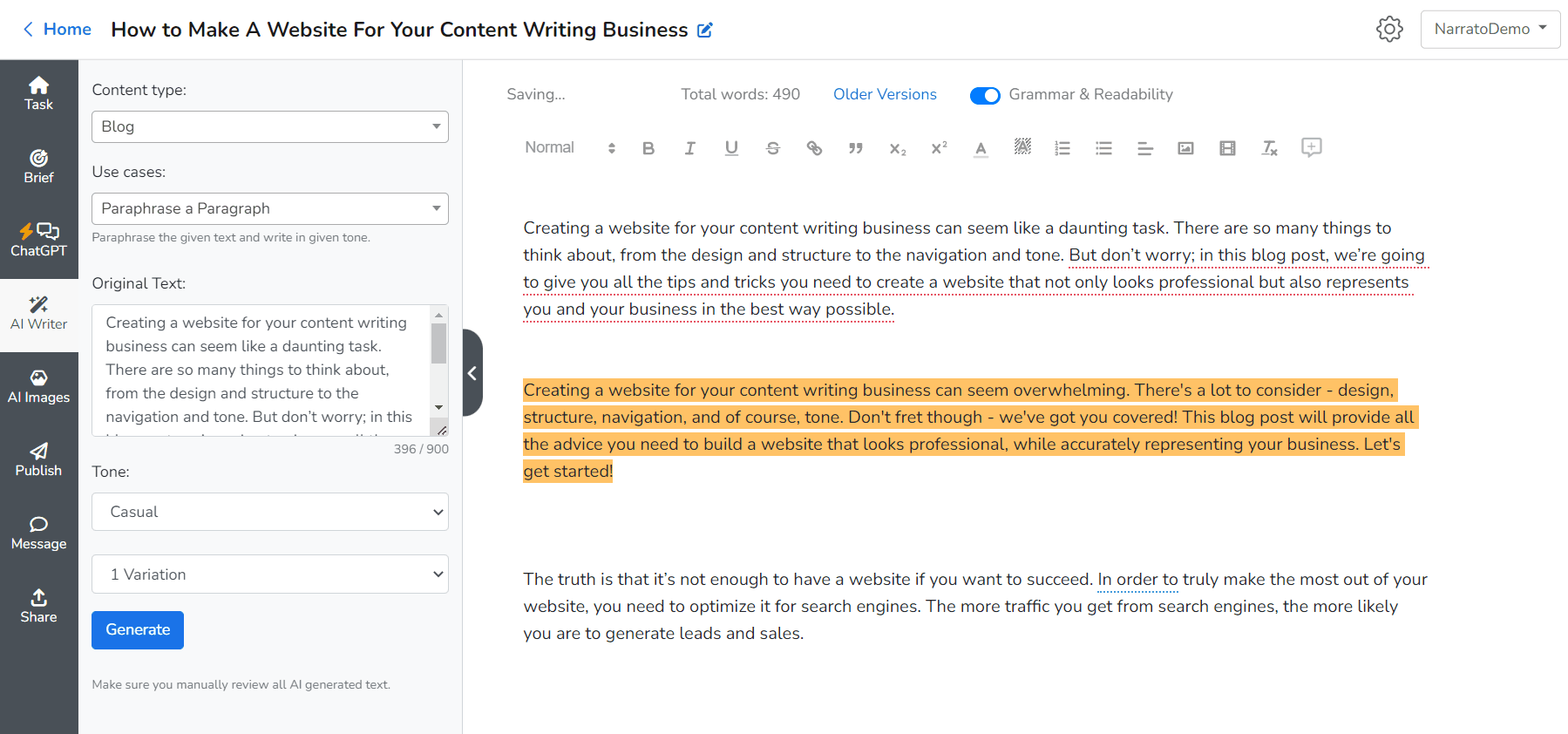
You can also read through the AI-generated content to see if the ideas flow smoothly. Wherever possible, add transitioning sentences to bind two paragraphs together and make the reading experience better,
5. Ensure the AI text matches your tone and style of writing
An important factor that you want to take into account when using AI-generated content is to see if it matches your brand’s tone and style. This is crucial not just for tricking AI content detectors but for your content’s overall performance too. If the content does not align with your tone and style, readers will notice the difference too. It will look inconsistent and half-hearted.
If part of your blog post or article has a different tone from the rest of the content, it also becomes easier for GPT detectors to identify it as AI content.
Make sure that the AI writing tool you use lets you define your tone and audience. If you’re using ChatGPT to generate content, define the tone and style you want to achieve in your input prompt.
6. Use ‘in the style of’ in your prompts for more personalized outputs
When using chat engines like ChatGPT, a good way to ensure that the AI content is in your desired style is by adding ‘in the style of’ in your prompts. For instance, if your writing style is similar to a popular blogger in your niche, just add a sentence saying “write in the style of [blogger name]” at the end of your prompt.
This will ensure that the AI content is aligned with the overall style and tone that your brand follows, and also make the output of the AI content generator more personalized and relatable.
7. Edit to make the content more conversational and natural
Depending on what kind of AI content creation tool you’re using, it is possible that the AI-generated content sounds very dry and robotic. AI content detectors can easily detect these patterns and flag your content because there will always be some difference between this and actual human-written text.
Add more human-like text to your AI content to make it sound more natural. Colloquialisms, exclamations, and other terms/words that trigger some kind of emotion are good ways to enhance your AI content and prevent detection.
8. Add intentional variations/ inconsistencies
AI-generated content usually does not have grammatical or spelling errors since it is generated by a machine. To make use of this factor in avoiding AI content detection, some experts suggest including some intentional spelling errors and typos in your content to make it look more human.
We, however, do not recommend this as it also reflects badly on your writers and your brand. You may bypass AI content detectors with these intentional errors, but this comes at the cost of your credibility and authority as a reliable information source for your audience.
What you can do instead is use alternate spellings or words. For instance, use both hyphenated and non-hyphenated forms of a word within your content. Switch between US and UK English spellings within the content if you are not targeting any specific market and have a global audience.
Making subtle changes like these will not be counted as errors and readers will probably not even notice them. But at the same time, you’re also tricking AI content detection tools to think that these are human errors. So it’s a win-win for you.
What to be careful about when trying to trick AI content detectors
These tips should help you outsmart and bypass AI content detectors. But it is important to remember that your primary goal should be to provide value to your audience and build authority for your brand – not to trick AI content detectors or search engines. To ensure that you’re using AI content generation tools to your advantage in the long run, here are a few other key points to remember:
- AI tools are evolving fast, so whatever your strategy is, you will have to revisit and update it regularly.
- Don’t compromise on content quality simply to speed up the process and bypass AI content detection. As long as there’s quality, neither search engines nor publishers care if the content was written by humans or AI.
- Use AI tools to write better, and not simply mass-produce content that has no value for the audience, for SEO, and for your brand.
- Be ethical even when using AI content generation tools. Avoid plagiarism or copyright infringement, and always fact-check to ensure you are not spreading misinformation.
With these key aspects of AI content creation in mind, you can actually create content that will drive conversions and boost authority for your business without the risk of getting flagged by GPT detectors. Try implementing these when you generate content using AI writers the next time and create with confidence.


